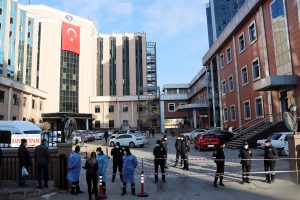SAN JOSE, CA – DEC. 18: Aimee Lopez Baena is the first staff member at Valley Regional Hospital to get a vaccine shot for COVID-19, Friday, Dec. 18, 2020, in San Jose, Calif. Registered nurse Wendy Dennis did the honors. (Karl Mondon/Bay Area News Group)
The first of nearly six million doses of the second COVID-19 vaccine were packed in boxes and put on trucks at Moderna sites on Saturday, destined for McKesson distribution centers and delivery to California and 63 other states, territories and other jurisdictions.
The operation, larger than last week’s Pfizer vaccine rollout, comes as the U.S. coronavirus death toll is climbing and experts fear that Americans will gather indoors for the holidays.
California expects 672,660 doses from Moderna and an additional 233,000 doses from Pfizer, bolstering efforts to protect front-line healthcare workers and residents of nursing facilities.
The Moderna vaccine is easier to ship and store, because it does not require super-cold freezer temperatures, unlike the Pfizer vaccine. It is also packed in smaller containers, holding only 100 doses each.
“This allows jurisdictions the flexibility to support hard to reach small and more rural areas,” Gen. Gustave F. Perna, the chief operating officer for Operation Warp Speed, told reporters on Saturday morning.
Fed Ex and UPS trucks will begin delivering vaccines and kits by Monday morning, he said.
In the Bay Area, counties receive different allotments, based on population and need. Santa Clara County expects 39,300 doses; Alameda County, 14,800 doses; Contra Costa County, 14,300 doses; Santa Cruz County, 2,800 doses and San Mateo County, 7,300 doses. San Francisco did not provide data by deadline.
These numbers do not include the allocations for specific hospitals in the region. They also do not include multi-county healthcare systems such as Kaiser, Sutter, Dignity and Seton, which receive their allotments directly from the state.
If given a choice between the Moderna and Pfizer vaccines, can you pick one? Or it is better to wait for the next vaccine in the 2021’s research pipeline?
“Get the first vaccine you can get, as soon as possible. Don’t comparison shop,” said Ken Kelley, a biotech executive and former senior advisor on the federal government’s Pandemic Preparedness and Vaccine at a Commonwealth Club event this week.
Both vaccines are 90% to 95% effective. Moderna’s vaccine tends to cause slightly more side effects, such as fevers, aches, and chills, than the Pfizer vaccine.
They are made using the same approach, injecting messenger RNA (mRNA) inside in oily nanoparticles into an arm muscle. The mRNA instructs our cells how to make a noninfectious viral protein. The body responds to this protein with a protective immune defense.
The weekend effort, set in motion after the Food and Drug Administration’s emergency authorization of the vaccine on Friday, comes as the U.S. coronavirus death toll has surpassed 321,000.
“With the availability of two vaccines now for the prevention of COVID-19, the FDA has taken another crucial step in the fight against this global pandemic that is causing vast numbers of hospitalizations and deaths in the United States each day,” said FDA Commissioner Stephen Hahn in a statement.
At Saturday’s media briefing, Operation Warp Speed’s Perna acknowledged that there was a “miscommunication” with states about how many doses of Pfizer’s vaccine would be initially available to them. California was told this week to expect a 44% reduction in the number of Pfizer doses it would receive.
He called it “a planning error” caused because he did not understand “with exactness” all of the steps between vaccine completion and release. The process and quality of the vaccine have not changed, he added.
The Moderna doses will ship from manufacturing sites to a “fill-finish” facility where the vaccine is put into vials and packaged for distribution by McKesson, according to the Wall Street Journal. The Somerset, N.J.-based pharmaceutical-services contractor Catalent Inc. has said it is working with Moderna to perform fill-finish work at its facility in Bloomington, Ind.
The McKesson facilities include two new cold-chain sites outside Memphis, Tenn., and Louisville, Ky.
“The fact that we are now at a point where we are likely to have multiple vaccines with very high effectiveness and few safety concerns in less than 12 months is extraordinary,” said Julie Swann, a professor and head of the industrial and systems engineering department at North Carolina State University in Raleigh, N.C., who advised the CDC during the H1N1 pandemic.
In many ways, the framework is similar to that used for distribution of the H1N1 vaccine, where state and local jurisdictions were able to tailor decisions to their environment and work with thousands of providers to get vaccine administered, said Swann.
But there are some differences that make the distribution of the COVID-19 vaccines more difficult, including the cold chain, the requirement of a second dose, and the months of existing burden on health departments. There have also been changes in organizational structure from the previous pandemic distribution and fast roll-out of new information systems, she said.
“The science has built on decades of previous work that was ready at the right point to move forward with this application,” said Swann.
Moderna vs. Pfizer vaccines. Here are the similarities and differences:
MODERNA:
Administration: two doses, four weeks apart
Production: Norwood, Massachusetts and Portsmouth, New Hampshire
Doses: 6 million doses
Needs to be stored at minus 4° F.
PFIZER:
Administration: two doses, three weeks apart
Production: Kalamazoo, Michigan
Doses: 2.9 million doses of the vaccine will be distributed during the “first round”
Needs to be stored at minus 94° F”]



















